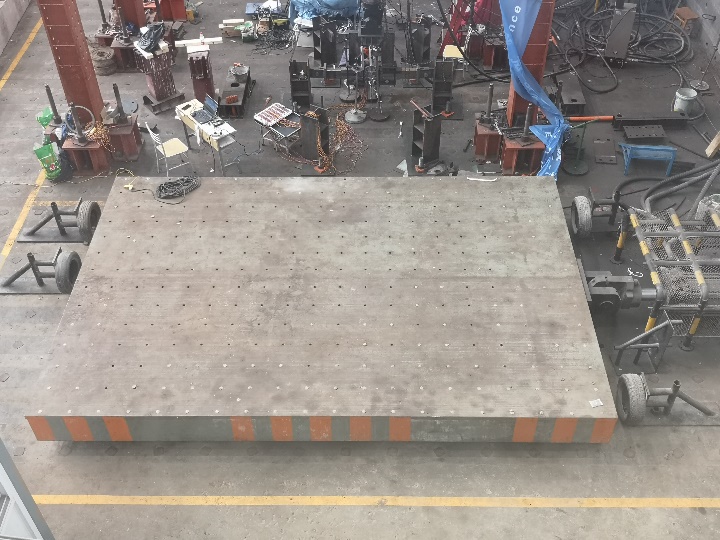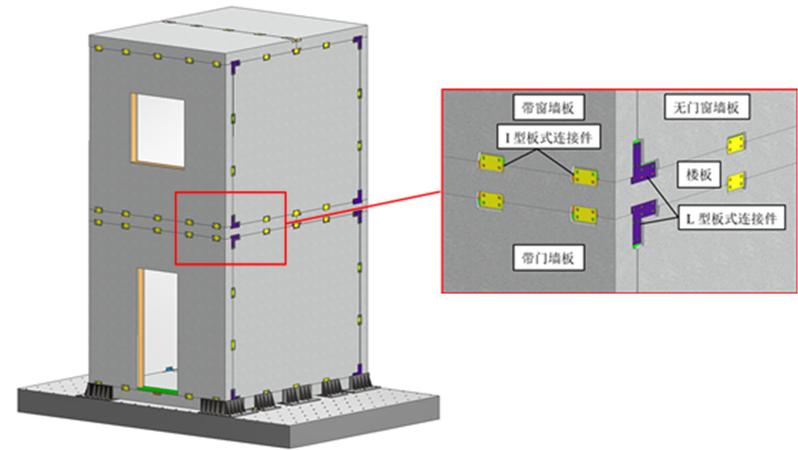预制装配式混凝土夹心墙板减震结构足尺振动台试验
随着中国快速的城镇化进程的不断发展,为满足人们日益增长的巨大住房需求,在城市和农村地区都存在着大量的住宅需要新建或者更换。目前中国农村自建住宅大多采用砖混结构或框架结构,通常没有考虑抗震设计或加固措施,易在地震、台风等自然灾害中发生较大程度的破坏,并且在施工中没有考虑保温措施导致建筑产生较大的热损失。与传统现浇施工方案相比,预制施工方案具有更高的施工质量、更好的结构耐久性、更快的施工安装过程与更高的施工安全性等优势,并且受到恶劣天气的影响较小(Kurama et al. 2018; O’Hegarty and Kinnane 2020; Singhal et al. 2019)。在农村地区的住宅市场中,预制装配式混凝土夹心墙板结构体系具有较大潜力,如图1所示。

图1 预制装配式混凝土夹心墙板结构住宅

图2 典型预制混凝土夹心板
预制混凝土夹心板由两层混凝土层与夹心绝缘保温层组成,混凝土层间由剪切连接件进行连接组成整体,形成了类似于三明治的构造形式,如图2所示为典型带有桁架型剪切连接件的预制混凝土夹心板。相关研究验证了预制混凝土夹心板具有良好的抗震性能、抗弯性能、抗剪性能和复合作用,可作为地震区中预制混凝土结构体系的墙板和楼板使用(Goh et al. 2014; Lee and Pessiki 2008; Naserpour and Fathi 2021; Palermo and Trombetti 2016; Pessiki and Mlynarczyk 2003)。当受到强烈水平地震荷载时,墙板与墙板之间和墙板与楼板之间的连接是至关重要的。一些研究表明,由螺栓形式的干式连接可以为预制混凝土结构提供足够的强度和刚度,以保持其结构完整性(Guo et al. 2019; Malla et al. 2021; Naserpour and Fathi 2021; Sun et al. 2019)。在结构减震控制技术中,粘弹性阻尼器作为被动消能减装置有着广泛的应用,具有高耗能、构造简单、安装方便、价格低廉和易于维护等优势。绝大多数粘弹性阻尼器耗能模式为粘弹性材料剪切变形耗能,典型的粘弹性阻尼器是由三块钢板之间硫化粘结两层粘弹性材料制成。在这种典型形式的基础上,又发展出一些新型阻尼器形式,如圆筒式阻尼器、方柱型阻尼器、扇形阻尼器和拉压型阻尼器等(Hsu and Fafitis 1992; Xu et al. 2017; Zhang et al. 2021)。与拉压型粘弹性阻尼器相比,剪切型粘弹性阻尼器存在大变形下易损坏、可恢复性较差的现象。
目前,对于预制装配式混凝土夹心墙板结构整体抗震性能的研究内容较为缺乏。现有的阻尼器大多仅考虑单一方向的减震控制,在如预制墙板结构一类的建筑中应用较为困难。此外,预制混凝土结构节点连接可靠性差,往往难以满足反复荷载下的受力要求。因此提出一种应用于预制墙板结构体系的新型多维减震装置,同时能够提高预制混凝土结构的整体性和抗震性能,该装置通过粘弹性材料压缩变形耗能。本次试验针对预制装配式混凝土夹心墙板结构(无控结构)和装有该新型多维减震装置的减震结构(有控结构)开展足尺振动台试验研究。

图3 水平液压振动台
本试验将在东南大学九龙湖校区土木工程实验中心的水平液压振动台上进行,如图3所示。试验模型为足尺的两层预制装配式混凝土夹心墙板结构,长3.8m,宽3m,总高6.2m。共由6块楼板和8块墙板组成,均为厚度为200mm的预制混凝土夹心板,角钢作为墙板和楼板的钢筋网架封闭式外框预埋在混凝土中,其中东西立面的墙板开有门洞和窗洞,墙板与墙板之间和墙板与楼板之间的连接均采用高强螺栓和镀锌连接件进行连接,如图4所示为试验结构三维示意图及连接详图。抗震设防烈度为8度,设计基本加速度为0.2g,抗震等级为二级,场地类别为Ⅱ类。

图4 试验结构三维示意图及连接详图
拟通过本次试验,了解预制装配式混凝土夹心墙板结构在地震荷载作用下的破坏模式和抗震性能,分析螺栓形式的干式连接构造在地震荷载作用下的受力性能,对比无控结构和有控结构的加速度和位移响应,对两者的抗震性能进行评价,探究新型多维减震装置的减震模式和减震效果。
References
[1]Goh, W. I., Mohamad, N., Abdullah, R., and Samad, A. A. A. (2014). “Finite element analysis of precast lightweight foamed concrete sandwich panel subjected to axial compression.” The 3rd International Conference on Computer Engineering and Mathematical Sciences, 35–41.
[2]Guo, W., Zhai, Z., Cui, Y., Yu, Z., and Wu, X. (2019). “Seismic performance assessment of low-rise precast wall panel structure with bolt connections.” Engineering Structures, Elsevier, 181, 562–578.
[3]Hsu, S., and Fafitis, A. (1992). “Seismic analysis design of frames with viscoelastic connections.” Journal of structural engineering, American Society of Civil Engineers, 118(9), 2459–2474.
[4]Kurama, Y. C., Sritharan, S., Fleischman, R. B., Restrepo, J. I., Henry, R. S., Cleland, N. M., Ghosh, S. K., and Bonelli, P. (2018). “Seismic-resistant precast concrete structures: state of the art.” Journal of Structural Engineering, American Society of Civil Engineers, 144(4), 3118001.
[5]Lee, B.-J., and Pessiki, S. (2008). “Experimental evaluation of precast, prestressed concrete, three-wythe sandwich wall panels.” PCI journal, 53(2).
[6]Malla, P., Xiong, F., Cai, G., Xu, Y., Larbi, A. S., and Chen, W. (2021). “Numerical study on the behaviour of vertical bolted joints for precast concrete wall-based low-rise buildings.” Journal of Building Engineering, Elsevier, 33, 101529.
[7]Naserpour, A., and Fathi, M. (2021). “Numerical study of demountable shear wall system for multistory precast concrete buildings.” Structures, Elsevier, 700–715.
[8]O’Hegarty, R., and Kinnane, O. (2020). “Review of precast concrete sandwich panels and their innovations.” Construction and building materials, Elsevier, 233, 117145.
[9]Palermo, M., and Trombetti, T. (2016). “Experimentally-validated modelling of thin RC sandwich walls subjected to seismic loads.” Engineering Structures, Elsevier, 119, 95–109.
[10]Pessiki, S., and Mlynarczyk, A. (2003). “Experimental evaluation of the composite behavior of precast concrete sandwich wall panels.” PCI journal, PRESTRESSED CONCRETE INSTITUTE, 48(2), 54–71.
[11]Singhal, S., Chourasia, A., Chellappa, S., and Parashar, J. (2019). “Precast reinforced concrete shear walls: State of the art review.” Structural Concrete, Wiley Online Library, 20(3), 886–898.
[12]Sun, J., Qiu, H., and Jiang, H. (2019). “Experimental study and associated mechanism analysis of horizontal bolted connections involved in a precast concrete shear wall system.” Structural Concrete, Wiley Online Library, 20(1), 282–295.
[13]Xu, Z., Gai, P., Zhao, H., Huang, X.-H., and Lu, L.-Y. (2017). “Experimental and theoretical study on a building structure controlled by multi-dimensional earthquake isolation and mitigation devices.” Nonlinear Dynamics, Springer, 89(1), 723–740.
[14]Zhang, C., Huang, W., Zhou, Y., and Luo, W. (2021). “Experimental and numerical investigation on seismic performance of retrofitted RC frame with sector lead viscoelastic damper.” Journal of Building Engineering, Elsevier, 44, 103218.
